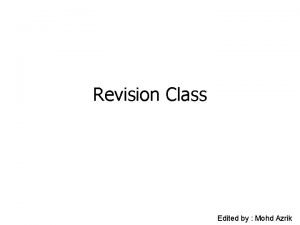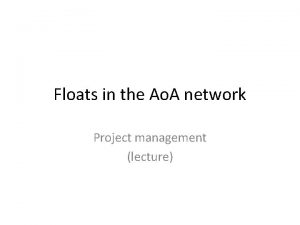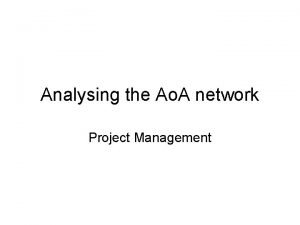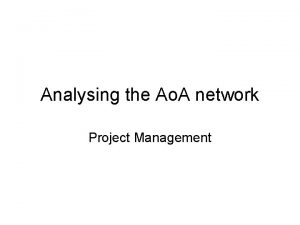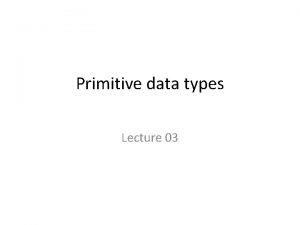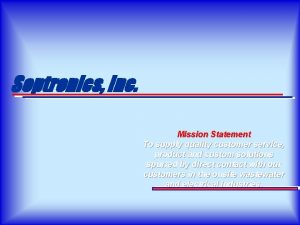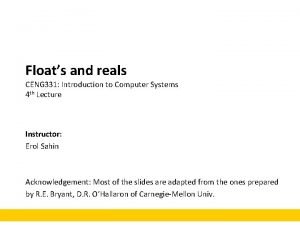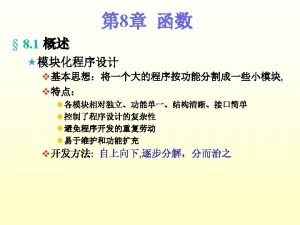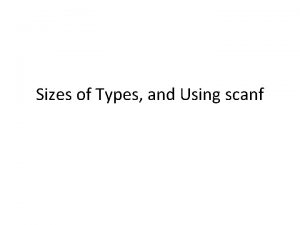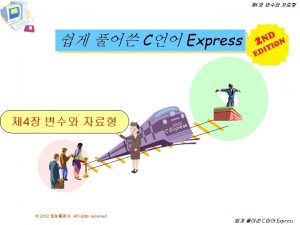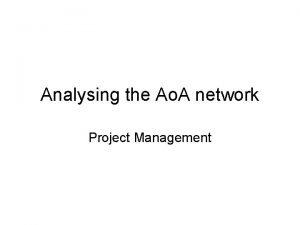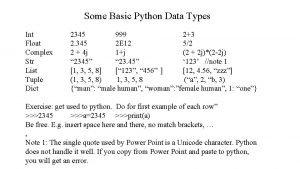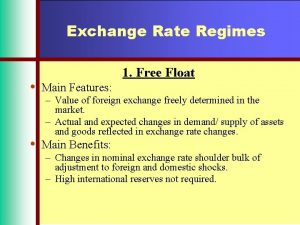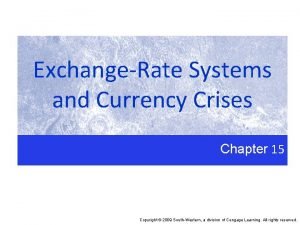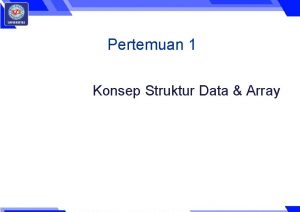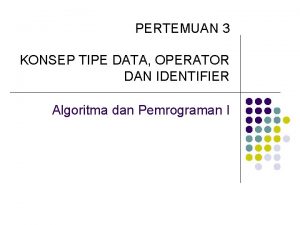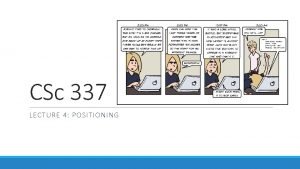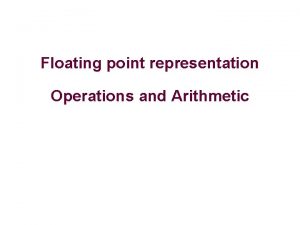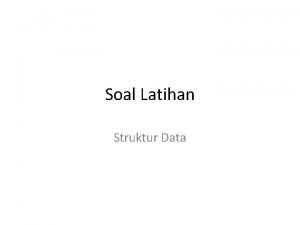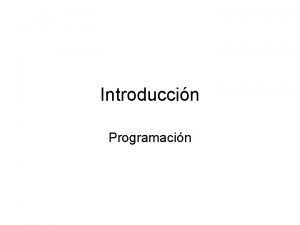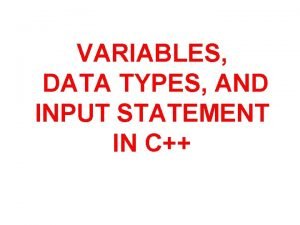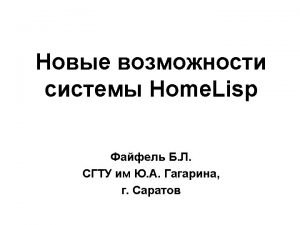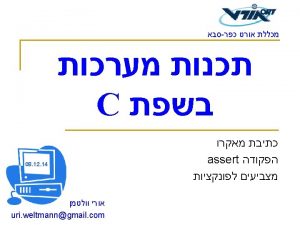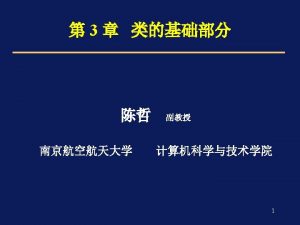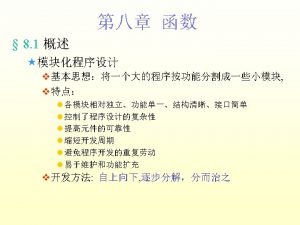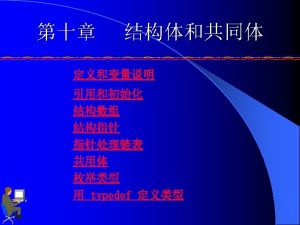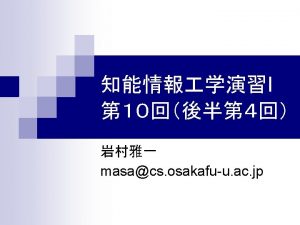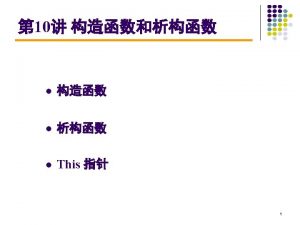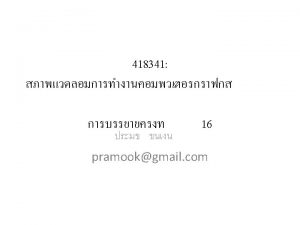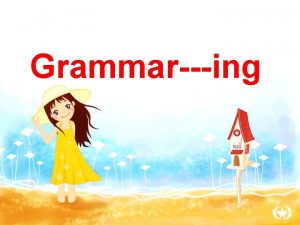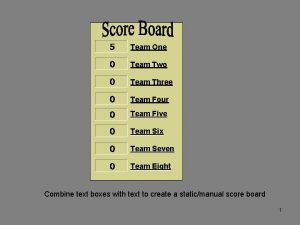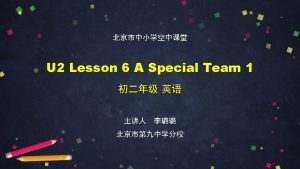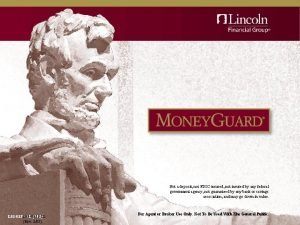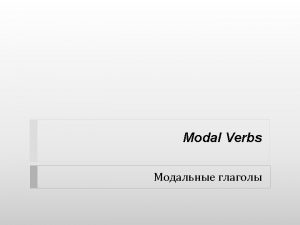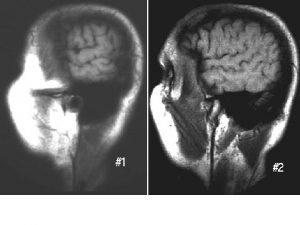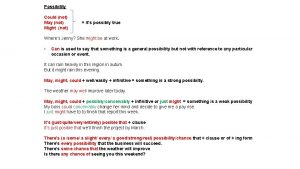To Float or Not to Float Team ShotNot




































- Slides: 36

To Float or Not to Float? Team Shot-Not Frank Balice, Matthew King Dongjun Lee, Michael Mohr

A Little History n n The Yuan or Renminbi is the official currency in the mainland of the People’s Republic of China. The Renminbi was first issued by the People’s Bank of China shortly before the Communist takeover in 1949.

Early Yuan Exchange Rate System n n n Under Communist Control (Command Economy) Value of Renminbi set to unrealistic values in exchange with western currencies. Severe currency exchange regulations.

Early Yuan Exchange Rate System n In 1978, the Chinese mainland opens its economy. n Dual Track Currency System Instituted Renminbi is usable only domestically. n Foreigners forced to use foreign exchange certificates. n Unrealistic pegged exchange rates Black Market Transactions n

Exchange Rate More Recently n n n From 1994 until July 2005 the Chinese have informally pegged the Yuan against the value of the U. S. Dollar. In 2003, this policy came under fire by the U. S. The fall in value of the dollar caused the Yuan to fall as well making Chinese exports more competitive. The G 7 and the European Union were also in favor of a re-evaluation of the Chinese exchange rate.

China’s Current Account First Half of 2006 : Exports = 428, 741 million USD Imports = 348, 775 million USD Trade Surplus = 79, 966 million USD Current Account Surplus = 90, 807 million USD n

World Bank on China’s Current Account The World Bank’s Beijing Office estimates this surplus will reach $220 billion (8. 3 % of China’s GDP) at the end of 2006. With an extra $65 billion from foreign direct investment inflows the surplus will reach $285 billion or 10. 7% of China’s GDP. n The World Bank believes that if China slows its economy by administrative controls on investment (like in 2004) less investment, domestic demand slower import growth even larger surplus n That is why the World Bank emphasizes that exchange rate appreciation should play a role this time around. It would help to slow China’s economy while also reducing China’s current account surplus. n

Reform & Convertibility n n In the late 80 s and early 90 s, China worked to make the yuan more convertible. Through the use of swap centers, the exchange rate was brought to realistic levels and the dual track currency system was abolished.

Reform & Convertibility n n The yuan is convertible on current accounts but not capital accounts. Ultimate goal is full convertibility. After the Asian Financial Crisis in 98, China was concerned that the mainland Chinese financial system would not be able to handle the potential rapid cross border movements of hot money. As of 2003, convertibility remains a distant goal.

Capital Controls n n Controls proved useful for centralized planning but growing adverse effects make reform inevitable. Early reform efforts were focused on relaxing restrictions on foreign exchange availability and embracing market forces, which led to the establishment of Chinese currency’s convertibility on the current account in 1994. New measures are directed at loosening up controls over capital account transactions to achieve “fundamental convertibility. ” With full convertibility on the current account but conditional convertibility on the capital account, that allows free longterm capital flows but restricts short-term capital flows.

No More Capital Controls? n n Recent reforms feature a strategy of selective liberalization. China is making progress in reducing the intensity of controls, particularly controls on capital outflow. New regime has emerged under which transactions in most international assets are freed though a number of capital transactions remain regulated. Meanwhile, China has pro-actively promoted international use of Chinese currency. These developments suggest the beginning of the end of capital controls in China.

Brief Economic and Political History n n n 1949 - Chinese Communist party comes into power after the Chinese civil war. 1950 s - Under the leadership of Mao Zedong, China shifts to a planned economy. 1958 -1962 Great Leap Forward n Steel and Agriculture Propaganda Poster “Take steel as the key link, leap forward in all fields”

Market Transition n December 1978, Two years after the death of Mao, Vice Premier Deng Xiaoping, established authority and called for economic reform. n n n Expand Rural Income Reduce Central Planning Create Special Economic Zones

Economic Zones n n Zones were used as an experiment for a market economy. Foreign investment is encouraged Tax and regulation exemptions Become rapid growth areas

Greater Free Market n n n Eliminated price controls in the economy Reformed land ownership, so farms could be privatized instead of collective Farmers could decide what to grow

Effects of the Free Market n n n Foreign direct investment grew from $916 million in ‘ 83 to $3. 5 billion in ‘ 90 Rural per capita real income doubled Both agricultural and industrial output grew at roughly 10% each per year

Second Wave of Reform n Increases in inflation (18. 5% 1988) and corruption lead to political unrest n n Tiananmen Square 1989 1992 - In response Deng goes on a southern tour to highlight the benefits of economic liberalization n Less restrictions on Foreign investment n n No longer required to set up joint ventures with Chinese Companies Can enter parts of the economy previously off limits

Mid 90 s Economy n n Large amounts of growth, with High Inflation Rate Asian Financial crisis - 1997

Turn of the Century Economic Reforms and Concerns n Banking Reforms China’s high savings rate n Bank dominated financial sector n n n 4 major banking institutions Fear of poor performing loans n Government assistance - 1. 4 trillion RMB and $60 billion to buy out bad loans n n Asset management companies 2003 -2005 $1 Trillion in new loans

Turn of the Century Economic Reforms and Concerns n External Sector n Pegged Currency 2005 - Expand to a basket of currencies n Constant US pressure to revalue n n Capital Controls n Limits on foreign direct investment to prevent capital flight

China Today n n GDP growth at 10% a year 2 nd largest economy in the world Projections to be leading world economy by 2020 2001 admittance to the WTO

Not All Peaches and Cream n Huge wealth disparity n n Political unrest n n 60% of population still struggling farmers No substantial political liberalization Human rights issues

Is the Yuan an Undervalued Currency? n n The Big Mac Index estimates that the Yuan is 59% undervalued. There are many estimates regarding the value of the Chinese Yuan but many economists agree that the Yuan is undervalued by at least 40%.

Is the Yuan an Undervalued Currency? n Problem in the global marketplace Chinese goods are cheaper in comparison to other goods. n United States can’t compete with China and its undervalued currency. n Important for farmers, manufacturers, and business people of the world to have a fair and accurate currency valuation for China. n

Is the Yuan an Undervalued Currency? n n The Bush administration has been encouraging the Central Bank of China to let its currency rise for many years now. In July of 2005, the Yuan appreciated by 2 percent. It was a start but still an inadequate increase.

Is the Yuan an Undervalued Currency? More recently, the Governor of the People’s Bank of China, Zhou Xiaochuan, said “the nation's banks are ``stronger'' and can cope with a more flexible Yuan. Since the Asian Crisis of 1997, the Chinese economy has grown much more resilient. China is now in a better condition to accept a more flexible exchange rate and other financial reforms. ” n

Is the Yuan an Undervalued Currency? Zhou told lenders to “prepare for changes to the currency so they can better manage risk created when a stronger Yuan makes exporter sales worth less in local currency terms”. He also said that “the range within which the Yuan trades against the U. S. dollar would be widened `sooner or later, and if the banks aren't pressured, their reforms would move too slowly. '' The Yuan has only appreciated 2. 9% since it was revalued in July of 2005. n

Is the Yuan an Undervalued Currency? In all of the essays and articles written about the Chinese economy, the general consensus is that the Yuan is greatly undervalued. Since the Asian financial crisis of 1997 -1998, the Chinese economy has gotten even stronger. The world’s economies are very concerned and are pushing China to take actions towards appreciating the Yuan. Analyst Publication Date of Publication Percent Yuan Undervalued World Bank PPP Level 2000 75% Big Mac Index The Economist Apr-03 56% Preeg MAPI Sep-02 40% Williamson IIE lecture Oct-03 over 25% Goldstein Congress Oct-03 15 -25%

To Float or not to Float? n Two Sides n TO FLOAT Slow the loss of U. S. manufacturing jobs n Possibly allow U. S. companies to export more to China n Lower the huge U. S. Trade deficit n n n ($561. 33 BILLION through first 11 months, 2004) Allow Asian trading partners to freely let their currencies appreciate

To Float or not to Float? n NOT TO FLOAT No dramatic change in manufacturing sector n Issue with China isn't the only problem n Trade deficit may have no specific change n Consumers able to buy “relatively” cheaper goods n U. S. interest rates may rise, and recession may occur n

To Float or not to Float? n TO FLOAT… n Artificially low prices of Chinese goods Hurts U. S. manufacturers n Businesses fail to compete n n n Can’t compete with low labor costs Can’t compete with abundant laborers n (1, 313, 973, 713 as of July ’ 06) Can’t compete with undervalued currency RESULTS? n Loss in jobs, trade deficit, dollar loses value

To Float or not to Float? n TO FLOAT… n With floating… Value of Yuan can appreciate n Causes Chinese goods to become more expensive and American goods to become cheaper n U. S. companies can “fairly” compete with China’s cheap prices n This will allow the trade deficit to shrink as Yuan appreciates……OR WILL IT? n

To Float or not to Float? n More about trade deficit n Some believe even with floating currency, a dramatic change in U. S. economy is unlikely. n For example, If China revalued its currency, export prices would not increase proportionately. n n China deals primarily in reprocessed goods, which means only a relatively small share of the value comes from China. U. S. Trade deficit 2004 = $561. 33 Billion n China’s contribution = $147. 71 billion n 10%, or $13. 5 billion related to apparel industry n The rest of the goods = reprocessed goods

To Float or not to Float? n NOT TO FLOAT… n Issue with China isn’t the only problem: n Ira Kalish – Global director of Consumer business at Deloitte Research n n “The fact that we have a current-account deficit is not because of the Chinese. It’s because of our own choice as a society to consume more than we produce. It would be foolish to think that a Chinese revaluation alone would correct our currentaccount deficit. ” Affects US directly: n n With Yuan appreciating, prices rises relative to the undervalued prices. As a result of the floating exchange rate, China does not need to acquire abundant foreign reserves anymore. For US, in order to attract more investors, interest rates must rise. This in turn, affects the US directly, as our credit interest rates rise drastically, we end up consuming, and spending less, which ultimately takes a toll on the economy.

To Float or not to Float? n THE REAL QUESTION n The question shouldn’t be “to float or not to float” but, “WHEN AND HOW TO FLOAT? ” Floating China’s currency is inevitable. n How to float? n n n Drastically? Two step process

Thank You! Questions?
 Total float vs free float
Total float vs free float Negative float in project management
Negative float in project management How to calculate slack in project management
How to calculate slack in project management Sadlier vocabulary workshop level d unit 1
Sadlier vocabulary workshop level d unit 1 The white team cheers for the blue team, just like
The white team cheers for the blue team, just like Going native project management
Going native project management Team spirit becomes team infatuation
Team spirit becomes team infatuation Total float= * 1 point lst-est lst-eft est-lft eft-lst
Total float= * 1 point lst-est lst-eft est-lft eft-lst Paraffin cube float or sink
Paraffin cube float or sink Int char float
Int char float Septronics tm-1
Septronics tm-1 Ability to float
Ability to float Ceng 240 metu
Ceng 240 metu N' python
N' python Float x='a' printf( f x)
Float x='a' printf( f x) Css float values
Css float values Size of float and double
Size of float and double Sink or float brainpop jr
Sink or float brainpop jr Double 자료형
Double 자료형 Est lst eft lft example
Est lst eft lft example Complex float python
Complex float python Weatherford float equipment
Weatherford float equipment Dirty float exchange rate
Dirty float exchange rate Array yang memiliki sangat banyak nilai nol nya disebut:
Array yang memiliki sangat banyak nilai nol nya disebut: Dirty float
Dirty float Jelaskan struktur data array
Jelaskan struktur data array Short long double float
Short long double float Floatover installation method
Floatover installation method Union myunion structure my structure integer m float n
Union myunion structure my structure integer m float n Operator identifier
Operator identifier Terminal float nec
Terminal float nec Ball float backwater valve
Ball float backwater valve Alignitems vs justify content
Alignitems vs justify content Float number
Float number Dari gambar ini, maka notasi infix yang dihasilkan adalah :
Dari gambar ini, maka notasi infix yang dihasilkan adalah : Para que sirve float en c++
Para que sirve float en c++ Float statement
Float statement
